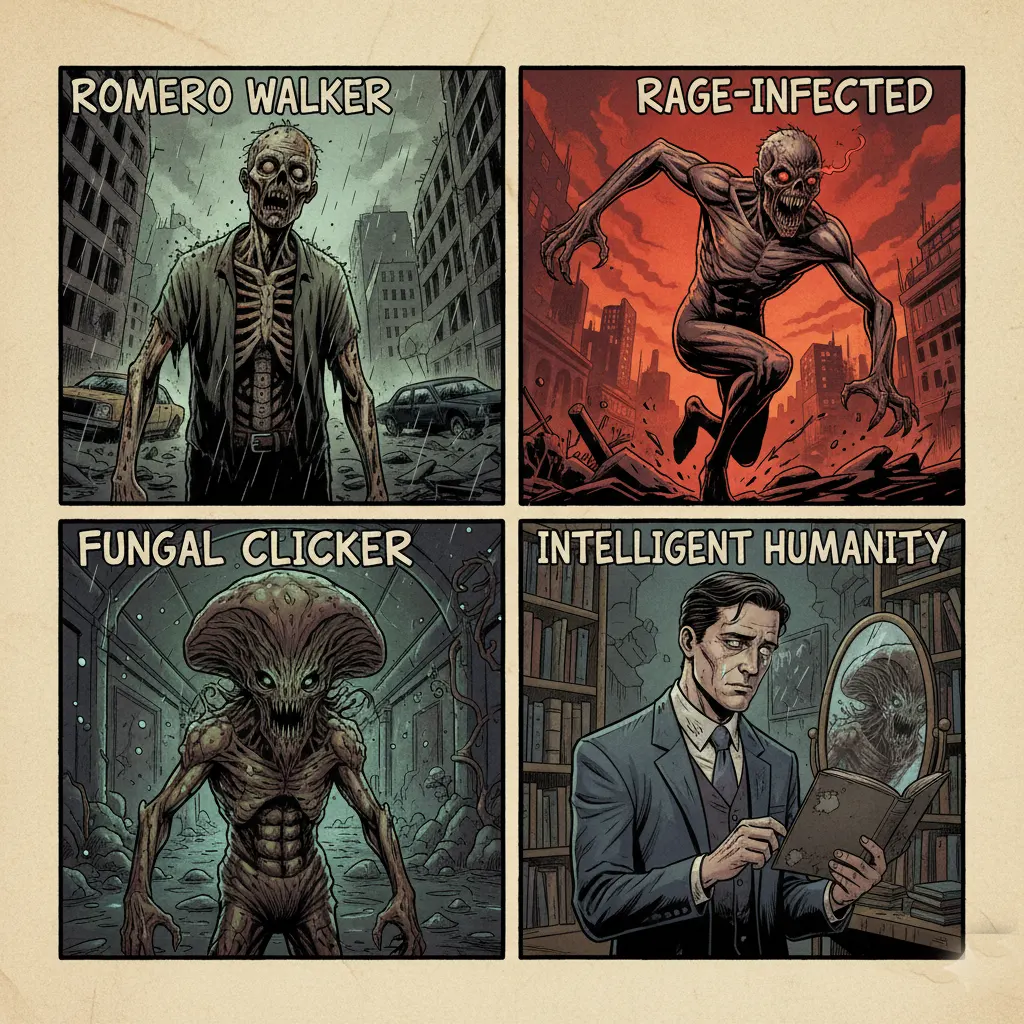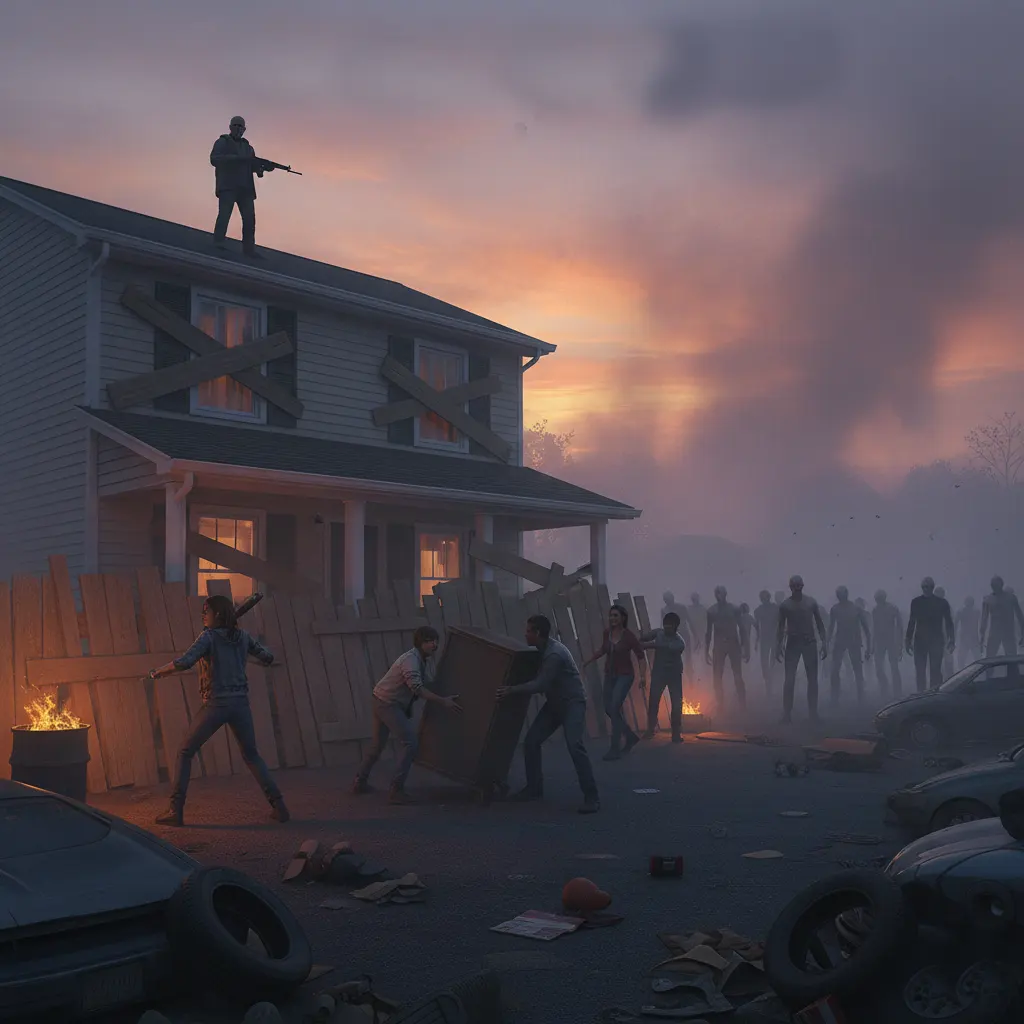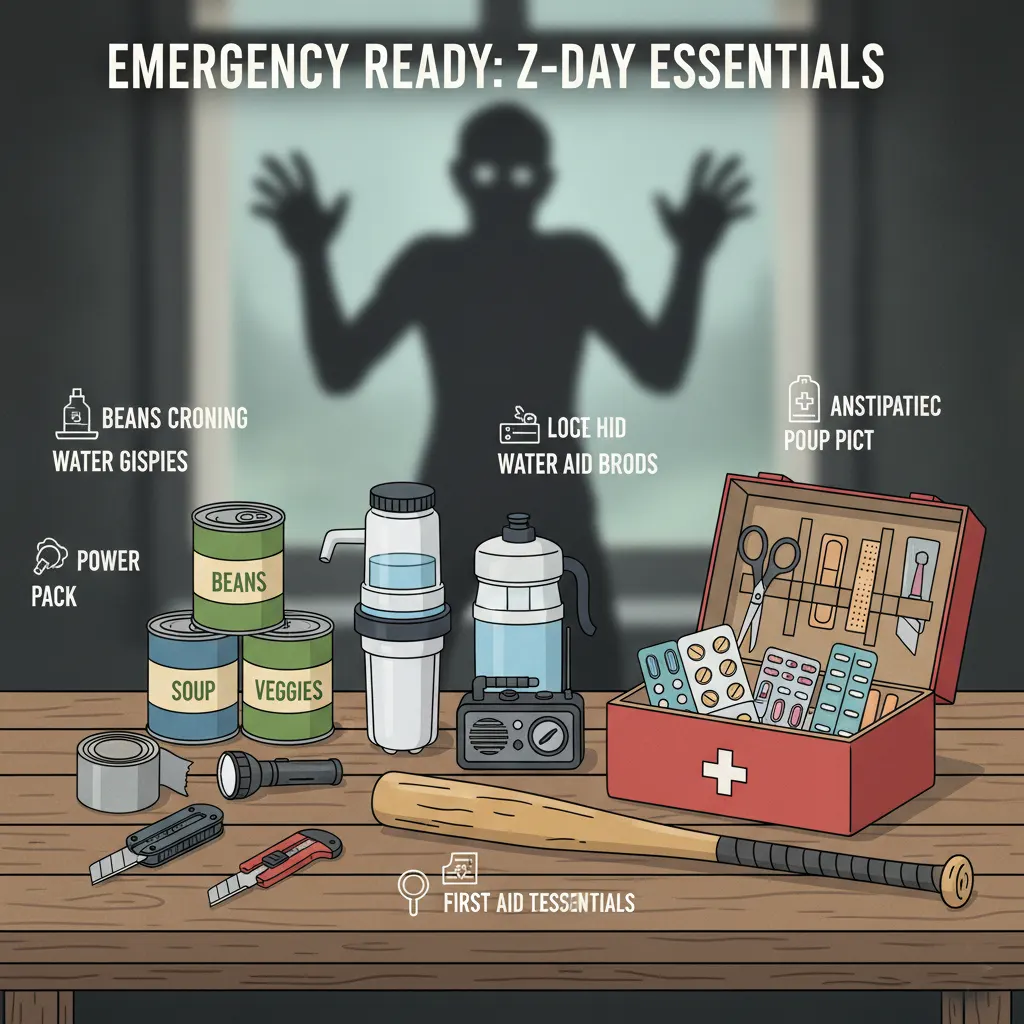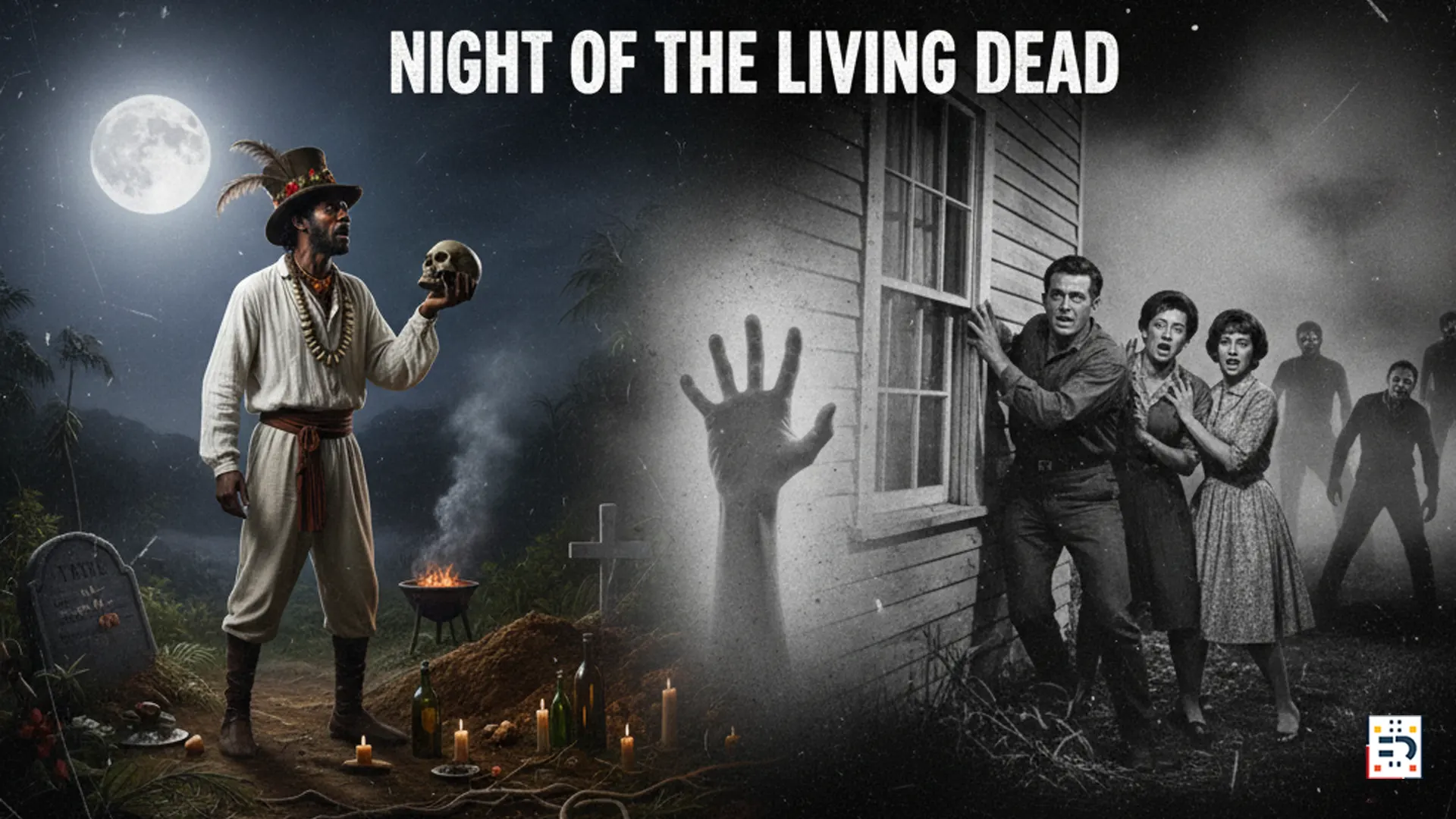Introduction: The Enduring Fascination with the Living Dead
Zombies have captivated American audiences for decades, evolving from terrifying creatures in horror films to complex metaphors for societal collapse, viral pandemics, and human survival. Whether you’re interested in zombie apocalypse preparedness, the latest zombie movies 2025, or understanding the science behind zombie infections, this comprehensive guide covers everything you need to know about the undead.
In 2025, zombies remain more relevant than ever, with major television series, upcoming films, and video games keeping the zombie genre at the forefront of popular culture. From The Last of Us Season 2 to discussions about zombie companies affecting the U.S. economy, the zombie phenomenon continues to evolve and fascinate millions of Americans.
What Are Zombies? Complete Definition & Characteristics
Basic Definition: Understanding the Undead
A zombie (also known as the undead, living dead, or walking dead) is traditionally defined as a reanimated corpse or a person who has lost consciousness, self-awareness, and higher cognitive function. In modern interpretations, zombies are often depicted as mindlessly hunting for human flesh, driven by primal instincts rather than rational thought.
According to Wikipedia’s comprehensive zombie definition, the term encompasses various cultural interpretations, from Haitian voodoo traditions to modern apocalyptic fiction.
Key Physical Characteristics of Zombies
Common Physical Traits:
- Decaying flesh and deteriorating body tissue
- Pale, grayish, or discolored skin
- Limited motor coordination and shambling gait
- Groaning, moaning, or gurgling sounds
- Various stages of decomposition (from fresh to skeletal)
- Milky or bloodshot eyes
- Open wounds and exposed bones
Behavioral Patterns:
- Lack of higher cognitive function (no reasoning or problem-solving)
- Driven by insatiable hunger (typically for human flesh or brains)
- Movement styles vary: slow shambling (classic zombies) or fast, aggressive sprinting (modern infected)
- Horde mentality – tendency to gather in large groups
- No fear response or pain sensitivity
- Attracted to noise, movement, and living humans
How Zombies Are Created: Methods of Zombification
Viral Infection (Most Common in Modern Media)
- Zombie virus spreads through bites, scratches, or bodily fluids
- Incubation period varies from minutes to hours
- Examples: The Walking Dead, World War Z
Fungal Infection
- Parasitic fungi control the host’s nervous system
- Inspired by real Cordyceps fungus affecting insects
- Featured prominently in The Last of Us franchise
Radiation Exposure
- Nuclear fallout causing reanimation (classic horror films)
- Examples: Early George Romero films
Voodoo/Supernatural Forces
- Traditional Haitian folklore origins
- Magical reanimation through rituals
- Control by witch doctors (bokors)
Parasitic Organisms
- Organisms controlling human hosts
- Keeping victims technically “alive” but controlled
Types of Zombies in Popular Culture
1. Classic Romero Zombies (Slow Zombies)
The original slow-moving zombies popularized by George A. Romero’s Night of the Living Dead (1968). These walkers shuffle slowly, lack intelligence, and can only be killed by destroying the brain. Most common in The Walking Dead series.

2. Fast Zombies (Rage-Infected)
Introduced in 28 Days Later (2002), these fast zombies sprint at full speed, making them far more terrifying and dangerous. Technically infected rather than undead, they exhibit extreme aggression and speed.
3. Intelligent Zombies
Some narratives feature zombies that retain partial intelligence, memory, or the ability to learn. Examples include Day of the Dead and Warm Bodies.
4. Fungal/Cordyceps Zombies
Based on real parasitic fungi, these infected humans are controlled by fungal growth overtaking their nervous system. Featured in The Last of Us, where victims progress through stages: runners, stalkers, clickers, and bloaters.
5. Viral Outbreak Zombies
Created by scientifically-plausible viruses or biological weapons. These stories emphasize pandemic spread, quarantine zones, and global collapse. Common in films like Resident Evil and World War Z.
History of Zombies: From Haitian Folklore to Modern Horror Films
Origins: Haitian Voodoo & the Birth of Zombie Mythology
The word “zombie” originates from Haitian Creole (“zonbi” or “zombi”), rooted in West African spiritual traditions brought to Haiti by enslaved peoples in the 17th and 18th centuries. In traditional Haitian Voodoo, zombies weren’t flesh-eating monsters but rather corpses reanimated through magical rituals by witch doctors called bokors.
According to folklore, enslaved people believed suicide would condemn them to exist as zombies – trapped in their bodies for eternity. This powerful mythology served as both spiritual belief and social control mechanism.
Evolution in American Popular Culture
1930s-1960s: Early Zombie Cinema
- White Zombie (1932) – First feature-length zombie film
- Focus on voodoo-controlled zombies
- Zombies as servants rather than monsters
1968: The Game-Changer George A. Romero’s Night of the Living Dead revolutionized the genre, creating the modern flesh-eating zombie archetype. The film introduced:
- Zombies craving human flesh
- Viral-like infection spread through bites
- Social commentary on racism and Cold War paranoia
- Post-apocalyptic survival scenarios
1970s-1990s: Genre Expansion
- Dawn of the Dead (1978) – Consumerism critique
- Day of the Dead (1985) – Military-scientist tensions
- Return of the Living Dead (1985) – “Braaaains!” pop culture
2000s-Present: Zombie Renaissance
- 28 Days Later (2002) – Fast zombies and viral outbreak
- Resident Evil franchise – Video game adaptations
- The Walking Dead (2010-2022) – Character-driven survival drama
- World War Z (2013) – Global pandemic scale
- The Last of Us (2023-present) – Fungal infection and emotional storytelling
Zombie Apocalypse: Could It Really Happen?
Scientific Plausibility of a Zombie Outbreak
While Hollywood zombies remain firmly in the realm of fiction, scientists have identified several real-world scenarios that share zombie-like characteristics:
1. Rabies Virus The closest real-world equivalent to zombie infection. Rabies causes:
- Extreme aggression and confusion
- Hydrophobia (fear of water)
- Hypersalivation and biting behavior
- Fatal if untreated
2. Cordyceps Fungus (Real Zombie Fungi) Parasitic fungi that control insect behavior, inspiring The Last of Us. While Cordyceps affects ants and other insects, it cannot currently infect humans due to our body temperature and immune systems.
3. Toxoplasmosis A parasitic infection affecting behavior in rodents (reducing fear of predators). Over 40 million Americans carry Toxoplasma, though effects on humans are subtle.
4. Prion Diseases Diseases like Creutzfeldt-Jakob disease cause rapid brain degeneration, though without contagion or reanimation aspects of zombie fiction.

Expert Consensus: Zombie Apocalypse Unlikely
Medical experts and epidemiologists agree that a true zombie outbreak as depicted in media remains scientifically impossible. The human body’s biological limitations, decomposition processes, and neurological requirements make reanimation implausible with current scientific understanding.
However, the CDC (Centers for Disease Control and Prevention) has used zombie apocalypse scenarios as engaging frameworks for emergency preparedness education. Their 2011 graphic novel “Preparedness 101: Zombie Pandemic” taught real-world emergency readiness using zombie metaphors.
Latest Zombie News & Trends in USA (2025)
Major Entertainment Releases
The Last of Us Season 2 (April 2025 Premiere)
HBO’s critically acclaimed series The Last of Us premiered its highly anticipated Season 2 in April 2025, continuing its adaptation of Naughty Dog’s acclaimed video game. The show features fungal-infected zombies called “clickers” in a post-apocalyptic America 25 years after outbreak. Starring Pedro Pascal and Bella Ramsey, the series has become a cultural phenomenon, praised for its emotional depth and impressive production values.
28 Years Later (June 2025)
The third installment in the legendary “28 Days Later” franchise is set to release in June 2025, continuing the story of rage-infected zombies that redefined the genre in 2002. The film promises to explore the long-term consequences of the outbreak decades later.
We Bury The Dead (January 2026)
Starring Daisy Ridley, “We Bury The Dead” will release in January 2026, presenting a fresh take where military authorities claim zombies are harmless and slow-moving, until the protagonist discovers they’re becoming dangerously violent.
Video Game Resurgence
Gaming industry analysts predict 2025 as a comeback year for zombie video games after years of market saturation. Highly anticipated titles include:
- Killing Floor 3
- John Carpenter’s Toxic Commando
- State of Decay 3 (rumored)
- Dead Island 2 expansions
Economic & Social Commentary
Zombie Companies in the U.S. Economy
“Zombie companies” – businesses unable to produce enough operating profit to pay loan interest for three consecutive years – represent approximately six percent of all publicly traded companies globally. These economically unsustainable businesses affect sectors including:
- Real estate
- Retail and brick-and-mortar stores
- Tourism and hospitality
- Technology startups
Financial analysts warn these companies drain economic resources and hinder healthy market growth.
Political & Social Metaphors
Zombie metaphors continue serving as powerful commentary on American society. Recent discussions explore whether political polarization, social media addiction, and collective trauma have Americans “acting like zombies” – functioning but disconnected from meaningful engagement.
Preparedness Culture
Best Cities for Zombie Apocalypse Survival
A May 2025 study ranked Oklahoma City as the third-best U.S. city for escaping a zombie outbreak, based on factors including:
- Population density (lower is better)
- Access to rural escape routes
- Road conditions and infrastructure
- Availability of supplies and resources
- Strategic geographic location
Other top-ranked cities include rural Midwest locations and mountain communities with natural barriers.
Zombie Survival Guide: Emergency Preparedness
Essential Zombie Apocalypse Survival Skills
While preparing for actual zombies isn’t necessary, emergency preparedness skills translate to any disaster scenario:
1. Food & Water Stockpiling
- Non-perishable foods (canned goods, dried foods)
- Water purification tablets and filters
- Minimum 72-hour emergency supply
- Long-term storage solutions
2. First Aid & Medical Supplies
- Comprehensive first aid kit
- Prescription medications (30-90 day supply)
- Antibiotics and antiseptics
- Medical reference guides
3. Defense & Security
- Home fortification strategies
- Self-defense training
- Safe rooms and escape routes
- Community watch programs
4. Communication
- Battery-powered radio
- Emergency contact plans
- Meeting locations for family members
- Alternative communication methods
5. Essential Tools
- Multi-tools and knives
- Fire-starting equipment
- Rope and duct tape
- Flashlights and batteries
Recommended Emergency Preparedness Resources
- CDC Emergency Preparedness – Official preparedness guidelines
- FEMA Ready.gov – Comprehensive disaster preparedness
- Red Cross Emergency App – Mobile emergency resources

Why Americans Love Zombie Entertainment
Psychological Appeal of Zombie Stories
Fear of Loss of Identity Zombies represent the ultimate loss of consciousness and self – a primal fear that resonates deeply with audiences concerned about maintaining individuality in modern society.
Social Collapse Scenarios Zombie narratives let audiences safely explore societal breakdown, revealing both the best and worst of human nature under extreme pressure.
Survival Instinct Activation These stories engage our fundamental survival instincts, allowing viewers to mentally prepare for crisis situations while experiencing the thrill from safety.
Moral Complexity Modern zombie media explores difficult questions: What makes us human? How far would you go to survive? When does survival justify immoral actions?
Cultural & Economic Impact
Entertainment Industry Revenue The zombie genre generates billions annually through:
- Film and television productions
- Video games and interactive entertainment
- Books, comics, and graphic novels
- Merchandise and collectibles
- Theme parks and immersive experiences
Social Phenomena
- Zombie Walks – Annual events in major U.S. cities
- Zombie Runs – Obstacle courses with zombie actors
- Escape Rooms – Zombie-themed puzzle experiences
- Cosplay Communities – Elaborate undead costumes
Zombies as Social Commentary
Throughout history, zombies have served as metaphors for:
- Consumerism (Dawn of the Dead mall setting)
- Conformity (mindless masses following trends)
- Pandemic fears (especially relevant post-COVID-19)
- Class warfare (privileged vs. working class survival)
- Technology dependence (smartphone “zombies”)
- Environmental collapse (nature reclaiming civilization)
Frequently Asked Questions About Zombies
What is a zombie?
A zombie is a fictional undead creature that has been reanimated after death or infected by a virus/pathogen that destroys higher brain function. Zombies are typically depicted as mindless creatures driven by hunger for human flesh.
Where did zombies originate?
Zombies originated in Haitian folklore and Voodoo traditions, where “zonbi” referred to corpses reanimated through magical rituals. The modern flesh-eating zombie was created by filmmaker George A. Romero in 1968.
Can zombies really exist?
No. While certain diseases (rabies, Cordyceps fungi) share zombie-like characteristics, actual reanimation of corpses or complete loss of consciousness with continued motor function is scientifically impossible with current understanding.
What’s the difference between zombies and infected?
Traditional zombies are reanimated corpses (undead). “Infected” are living humans controlled by disease/parasite (like in 28 Days Later or The Last of Us). Infected are technically alive; zombies are dead but mobile.
How do you kill a zombie?
In most zombie fiction, destroying the brain is the only way to permanently stop a zombie. This includes headshots, severe head trauma, or decapitation. Some stories also feature fire as effective.
What causes a zombie apocalypse?
Common fictional causes include: viral infections, fungal parasites, radiation exposure, biological weapons, supernatural forces, or unexplained phenomena. Each narrative creates its own rules.
Are there different types of zombies?
Yes. Main types include: slow Romero zombies (walkers), fast rage-infected zombies (runners), fungal zombies (clickers), intelligent zombies, and voodoo zombies.
What are zombie companies?
In economics, “zombie companies” are businesses unable to cover debt interest payments from operating profits for extended periods. They survive on continual refinancing rather than actual profitability.
Is zombie apocalypse preparedness useful?
Yes! While zombies aren’t real, emergency preparedness skills (food/water storage, first aid, evacuation planning) apply to real disasters like hurricanes, earthquakes, pandemics, and power outages.
What are the best zombie movies?
Classic must-watch zombie films include: Night of the Living Dead (1968), Dawn of the Dead (1978), 28 Days Later (2002), Shaun of the Dead (2004), World War Z (2013), and Train to Busan (2016).
The Undying Appeal of Zombies in 2025
Zombies have evolved from Haitian folklore into multifaceted cultural symbols representing everything from viral pandemics to economic instability, social conformity to existential fears. In 2025, the undead continue dominating American entertainment and consciousness, with major television productions like The Last of Us Season 2, upcoming films like 28 Years Later, and a resurgence in zombie video games keeping the phenomenon alive and relevant.
Whether serving as horror entertainment, social commentary, or emergency preparedness metaphors, zombies remain deeply embedded in American popular culture. Their enduring popularity reflects our ongoing fascination with survival, society’s fragility, and fundamental questions about humanity, consciousness, and what happens when civilization’s thin veneer crumbles.
As the entertainment industry continues producing high-quality zombie content that combines visceral thrills with emotional depth and social commentary, audiences remain hungry for stories about the walking dead. The zombie apocalypse may be fictional, but its cultural impact and symbolic power are undeniably real.
Stay Prepared, Stay Informed
Whether you’re a fan of zombie horror movies, interested in apocalypse survival strategies, or simply fascinated by undead mythology, understanding zombies provides insight into both entertainment trends and genuine emergency preparedness.
Remember: In any emergency scenario – zombie or otherwise – having a plan, supplies, and knowledge can make the difference between survival and catastrophe.
#Zombies #ZombieApocalypse #SurvivalGuide #ZombieTrends2025 #TheLastOfUs #HorrorFans #Undead #ApocalypsePrep #ZombieCulture #USATrends


